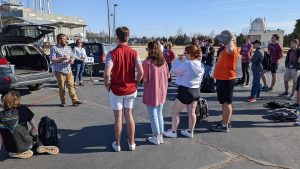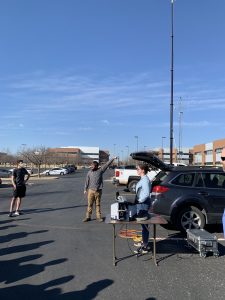Teaching Meteorology Instrumentation
In the Spring 2022 semester my colleague from GeoCarb, Elizabeth Spicer, and I escaped the lab and went teaching meteorology instrumentation. Each year, the OU METR 3613 Meteorological Measurement Systems class hosts a workshop. On that day, the students leave the classroom setting to meet with subject experts. Members of research groups at the OU National Weather Center demonstrate their equipment. On that day, Elizabeth and I demonstrated two projects. The first was the Bruker EM-27/Sun we use for total column atmospheric measurements plus all of the meteorological instruments that accompany it. The second was the sensor array from my dissertation project.

How the Demo Worked
Elizabeth and I took our equipment to the parking lot near the National Weather Center. There, we set up our gear like vendors at a swap meet. One one table was the EM-27/Sun and another table the sensor array. The secondary instrumentation for the EM-27/Sun was set up atop my car. The weather station part can be seen mounted on the mast in the image below. Other groups set up their own equipment including the National Severe Storms Lab stormchaser truck and Mesonet. The class then cycled to individual stations to hear the demo.
I really enjoyed teaching meteorology instrumentation, because I was able to bring something unexpected. Most of the students there learn about the usual meteorology tools, but using those tools in conjunction with chemical concentration sensors is new to them. It gives them the opportunity to see the “how” and “why” instruments are used elsewhere. Of course, I love any opportunity to teach labs. I put on my stage presence and directly interact with the students. Since the students already have some instrument knowledge by that time in the semester, I ask them questions. “What is this instrument?” “How am I using it?” “Why do I want this instrument AND this other instrument?”
